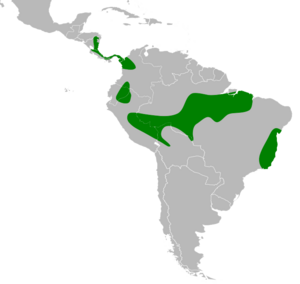Rufous-vented ground cuckoo facts for kids
Quick facts for kids Rufous-vented ground cuckoo |
|
|---|---|
 |
|
| Conservation status | |
| Scientific classification | |
| Genus: |
Neomorphus
|
| Species: |
geoffroyi
|
 |
|
The rufous-vented ground cuckoo (Neomorphus geoffroyi) is a special type of cuckoo bird. It's known as a Vulnerable species, which means it needs our help to survive in the wild. You can find this bird in several countries, including Bolivia, Brazil, Colombia, Costa Rica, Ecuador, Nicaragua, Panama, and Peru.
Contents
About the Rufous-Vented Ground Cuckoo
Different Types of Ground Cuckoos
Scientists group animals into categories. For the rufous-vented ground cuckoo, most experts agree there are six main types, called subspecies. These are like different versions of the same bird, with small differences.
- N. g. salvini
- N. g. aequatorialis
- N. g. australis
- N. g. amazonicus
- N. g. geoffroyi
- N. g. dulcis
Some bird experts even think there might be a seventh type, N. g. squamiger, which others consider a completely separate species.
What Does It Look Like?
The rufous-vented ground cuckoo is a medium-sized bird. It is about 45 to 51 centimeters (18 to 20 inches) long. About half of its length is its long tail! It weighs between 300 and 400 grams (11 to 14 ounces).
This cuckoo has a strong, curved beak. The beak is usually pale grayish-green with a yellow tip. A cool feature is its shaggy, shiny blue-black crest on its head. It also has bright blue skin around its eyes. The area under its tail, called the vent, is a reddish-brown color. Both male and female birds look very similar.
The most common type, N. g. geoffroyi, has a cinnamon-brown head and face. Its back and wings are a bronzy olive-green. Its tail is a shiny purple. It has a light chest with a black band across it. Its head and chest have a pattern that looks like scales. Other subspecies have slightly different colors, like darker backs or different shades of gray on their undersides.
Where It Lives and Its Home
Distribution of the Cuckoo
These cuckoos live in different parts of Central and South America:
- N. g. salvini: From Nicaragua, through Costa Rica and Panama, and down the Pacific coast of Colombia.
- N. g. aequatorialis: Southeastern Colombia, eastern Ecuador, and northern Peru.
- N. g. australis: Southeastern Peru and northwestern Bolivia.
- N. g. amazonicus: In the Amazon region of Brazil, south of the Amazon River.
- N. g. geoffroyi: In the Bahia state of eastern Brazil.
- N. g. dulcis: Southeastern Brazil, from Espírito Santo to Rio de Janeiro.
Its Forest Home
The rufous-vented ground cuckoo prefers to live in old, untouched evergreen forests. You might also find it near rivers, in forests that flood sometimes, or even in dry forests. In Central America, it lives from sea level up to about 1,450 meters (4,760 feet) high. In South America, it can be found from sea level up to 1,650 meters (5,410 feet) high in Bolivia.
Cuckoo Behavior
How It Moves Around
This cuckoo stays in the same area all year long. It doesn't migrate to different places.
Walking and Running
The rufous-vented ground cuckoo spends almost all its time on the ground. It mostly walks or runs through the forest. If it needs to escape danger, it might fly low or jump into a tree. It can make powerful leaps to catch its food!
What It Eats
This bird mainly eats insects. It also enjoys other small creatures like spiders and scorpions. Sometimes, it eats small animals such as lizards, frogs, or even tiny birds. Occasionally, it will eat fallen fruits. A clever trick it uses is following groups of army ants, wild pigs (peccaries), or monkeys. It catches the insects and other small animals that try to run away from these groups.
Reproduction and Life Cycle
The breeding season for the rufous-vented ground cuckoo changes depending on where it lives. In Central America, they nest in the northern summer. In most of South America, they nest in the southern summer.
They build a strong nest using large sticks. The inside of the nest is a flat cup made of dry grass and fresh leaves. Nests are usually placed in a tree or bush, about 2 to 3 meters (7 to 10 feet) above the ground. So far, every nest found has had only one egg. Both parents are thought to help hatch the egg. We don't know exactly how long it takes for the egg to hatch or for the baby bird to leave the nest. However, it's probably similar to other cuckoos, which is about 20 days.
What Does It Sound Like?
The main sound the rufous-vented ground cuckoo makes is a low, long, sad coo. It sounds like "ooooooooooooooooop". When they are following army ants, they make a quiet, barking "woof" call. They also make a sharp, loud "kchak!" sound. This call seems to be used to tell other birds to move away from the food they want!
Its Status and Protection
The IUCN (International Union for Conservation of Nature) has listed the rufous-vented ground cuckoo as a Vulnerable species. This means it is at risk of disappearing. There are an estimated 63,000 to 127,000 adult birds left, and their numbers are going down.
Even though it lives in many places, its habitat is spread out and broken up. The biggest threat to this bird is that its forest home is being destroyed or cut into smaller pieces. This cuckoo needs large, undisturbed forests to survive. It is often one of the first birds to disappear when its forest home gets broken up.


